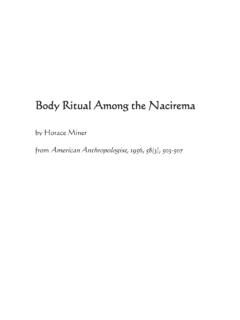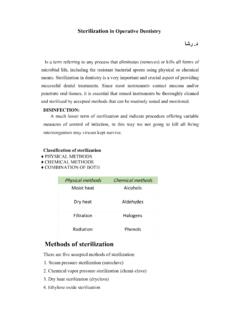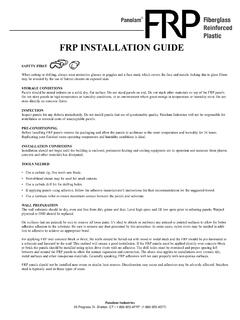Transcription of BODY RITUAL AMONG THE NACIREMA - IWLA
1 BODY RITUAL AMONG THE NACIREMA (Adapted from article by Horace Miner) In this article, Horace Miner demonstrates that attitudes about the body have an influence on many institutions in Nacireman society. The magical beliefs and practices of the NACIREMA present such unusual aspects that they will be described here as an example of the extremes to which human behavior can go. The RITUAL of the NACIREMA was first brought to the attention of anthropologists in 1936, but the culture of this people is still very poorly understood. Little is known of their origin, although tradition states that they came from the east. NACIREMA culture is characterized by a highly developed market economy which has evolved in a rich natural habitat. While much of the people's time is devoted to economic pursuits, a large part of the fruits of these labors and a considerable portion of the day are spent in RITUAL activity. The focus of this activity is the human body, the appearance and health of which loom as a dominant concern of the people.
2 While such a concern is certainly not unusual, its ceremonial aspects and associated philosophy are unique. The fundamental belief underlying the whole system appears to be that the human body is ugly and that its natural tendency is to debility and disease. Man's only way of avoiding these characteristics is through the use of RITUAL and ceremony. Every household has one or more shrines devoted to this purpose. While each family has at least one such shrine, the rituals associated with it are not family ceremonies but are private and secret. The rites are normally only discussed with children, and then only during the period when they are being initiated into these mysteries. The focal point of the shrine is a box or chest which is built into the wall. In this chest are kept the many charms and magical potions without which no native believes he could live. These preparations are secured from a variety of specialized practitioners. The most powerful of these are the medicine men, whose assistance must be rewarded with substantial gifts.
3 However, the medicine men do not provide the curative potions for their clients, but decide what the ingredients should be and then write them down in an ancient and secret language. This writing is understood only by the medicine men and by the herbalists who, for another gift, provide the required charm. The charm is not disposed of after it has served its purpose, but is placed in the charm box of the household shrine. As these magical materials are specific for certain ills, and the maladies of the people are many, the charm box is usually full to overflowing. The magical packets are so numerous that people forget what their purposes were and fear to use them again. We can only assume that the idea in retaining all the old magical materials is that their presence in the charm box will in some way protect the worshiper. Beneath the charm box is a small font. Each day every member of the family enters the shrine room, bows his head before the charm box, mingles different sorts of holy water in the font, and proceeds with a brief rite of cleansing.
4 The holy waters are secured from the Water Temple of the community, where the priests conduct elaborate ceremonies to make the liquid ritually pure. In the hierarchy of magical practitioners, and below the medicine men in prestige, are specialists whose designation is best translated as "holy- mouth -men"? The NACIREMA have an almost pathological horror of and fascination with the mouth , the condition of which is believed to have a supernatural influence on all social relationships. Were it not for the rituals of the mouth , they believe that their teeth would fall out, their gums bleed, their jaws shrink, their friends desert them, and their lovers reject them. The daily body RITUAL performed by everyone includes a mouth -rite. This rite involves a practice which strikes the stranger as revolting. The RITUAL consists of inserting a small bundle of hog hairs into the mouth , along with certain magical powders, and then moving the bundle in a highly formalized series of gestures.
5 The people seek out a holy- mouth -man once or twice a year. These practitioners have an impressive set of tools. The use of these items in the exorcism of the evils of the mouth involves almost unbelievable RITUAL torture of the client. The holy- mouth -man opens the client's mouth and enlarges any holes which decay may have created in the teeth. Magical materials are put into these holes. In the client's view, the purpose of this is to stop decay and to draw friends. The extremely sacred and traditional character of the rite is evident in the fact that the natives return to the holy- mouth -men year after year, despite the fact that their teeth continue to decay. One only has to watch the gleam in the eye of the holy- mouth -man, as he jabs an awl into an exposed nerve, to suspect that a certain amount of sadism is involved in the personality of this population. Most of the population shows definite masochistic tendencies. These tendencies are exhibited in the daily body RITUAL which is performed by men.
6 This part of the rite includes scraping and lacerating the surface of the face with a sharp instrument. Special women's rites are performed only four times during each lunar month, but what they lack in frequency is made up in barbarity. As part of this ceremony, women bake their heads in small ovens for about an hour. The medicine men have an imposing temple, or Latipso, in every community of any size. The more elaborate ceremonies required to treat very sick patients can only be performed at this temple. These ceremonies involve not only the miracle worker, but a permanent group of vestal maidens who move about the temple chambers in distinctive costume and headdress. The Latipso ceremonies are so harsh that it's amazing that a fair proportion of the really sick natives who enter the temple ever recover. Small children have been known to resist attempts to take them to the temple because "that is where you go to die." Despite this fact, sick adults are not only willing but eager to undergo the RITUAL purification, if they can afford to do so.
7 No matter how ill the supplicant or how grave the emergency, the guardians of many temples will not admit a client if he cannot give a rich gift to the custodian. Even after one has gained and survived the ceremonies, the guardians will not permit the client to leave until he makes still another gift. The supplicant entering the temple is first stripped of all his or her clothes. In everyday life the NACIREMA avoids exposure of his body and its natural functions. Bathing and excretory acts are performed only in the secrecy of the household shrine, where they are ritualized as part of the body-rites. Psychological shock results from the fact that body secrecy is suddenly lost upon entry into the Latipso. Few supplicants in the temple are well enough to do anything but lie on their hard beds. The daily ceremonies involve discomfort and torture. With RITUAL precision, the vestals awaken their miserable charges each dawn and roll them about on their beds of pain while performing cleansing rites, in the formal movements of which the maidens are highly trained.
8 At other times they insert magic wands in the supplicant's mouth or force him to eat substances which are supposed to be healing. From time to time the Medicine men come to their clients and jab magically treated needles into their flesh. The fact that these temple ceremonies may not cure, and may even kill the client, in no way decreases the people's faith in the medicine men. There is another kind of practitioner known as a "listener". This witch doctor has the power to exorcise the devils that lodge in the heads of people who have been bewitched. The patient simply tells the "listener" all his troubles and fears, beginning with the earliest difficulties he can remember. The memory displayed by the NACIREMA in these exorcism sessions is truly remarkable. Mention must be made of certain practices which have their base in native esthetics but which depend upon the pervasive aversion to the natural body and its functions. There are RITUAL fasts to make fat people thin and ceremonial feasts to make thin people fat.
9 Still other rites are used to make women's breasts larger if they are small and smaller if they are large. Our review of the RITUAL life of the NACIREMA has certainly shown them to be a magic-ridden people. It is hard to understand how they have managed to exist so long under the burdens which they have imposed upon themselves. ** INSTRUCTIONS FOR "BODY RITUAL AMONG THE NACIREMA " 1. Read the entire article. Look up any words you don't understand. 2. On LOOSELEAF PAPER in ENGLISH, write the following. a) In your OWN words, write a 5-6 sentence summary of the article. b) Have you ever read this article before? (If you have, DO NOT tell anyone else the secret!) c) In your opinion, what is the purpose of this article? d) What did you learn about yourself based on this article? e) What does this article have to do with studying a Foreign Language? f) Who are the NACIREMA ? 3. According to the article, write the definitions (on this sheet) of the following: a) "Household shrine" b) "Shrine box/chest" c) "Medicine men" d) "Herbalists" e) "Gifts" f) "Ancient and secret language" g) "Charm" h) "Font" i) "Holy mouth men" j) "Bundle of hog hairs" k) "Sharp instrument used by men to scrape and lacerate the surface of the face" l) "Small ovens " m) "Latipso" n) "Vestal maidens" o) "Magic wands" p) "Listener" q) " RITUAL fasts" r) "Ceremonial feast" **Draw a photo of the NACIREMA







